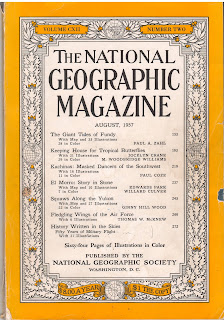Having accounted for the family in her first letter of 1958
(12 March), Bishop turned to a literary topic: “‘The Diary’ is doing pretty
well, I think.” By which she meant her translation, The Diary of ‘Helena Morley’.”
Bishop told Grace that it was already into a second edition
and was getting “very good reviews.” She couldn’t tell her aunt “how many
copies have been sold yet.” In the end, not as many as she had hoped.
Bishop sent Grace a copy, but the niece was unsure if the
aunt had received it. She thought not (partly because Grace was gallivanting),
“I do think you’ll enjoy it when you get your copy.” [Grace did receive her
copy and it is now resident at Acadia University Archives.]
It is not known what Grace’s response was, but knowing
something of her sense of humour, she undoubtedly enjoyed it, as Helena has quite an
attitude about life. Bishop said that Helena’s
Diamantina reminded her of rural Nova
Scotia. And there were remarkable echoes, indeed.
Interestingly, Bishop admitted to Grace that “it was hard to
make it sound natural.” As she explained to others, Portuguese is a more
formal language than English. In her effort to do so, when she “got stuck about
how to translate them literally,” she said she tried “to think of what Gammie
would have said! I think it worked pretty well.”
In 1999 I had the privilege of going to a Bishop conference
in Ouro Prêto, Brazil. Brett Millier kindly
invited me to present a paper on a panel she put together. My topic was
Bishop’s translation of this book. Here is a brief paragraph from that talk,
which speaks to the above claim:
While she tried to remain true to the tone and texture of the original,
Bishop incorporated a good deal of her own colloquialism and idiom into the
translation. I offer only one interesting example — there are many. One of
Bishop’s favourite words was “awful” (and its variations). Listen to how many
ways Bishop brings it into the translation: “awfully sorry,” “awfully funny,”
“perfectly awful,” “how awful,” “awful things,” “something awful,” “an awful
lot,” “this awful fault,” “that awful dentist,” “it’s awful,” “the rice is
awful,” “it must be awful,” “so awful,” “awful uproar,” “really awfully bad,”
“too awful,” “an awful shock.” And, again, there are many more examples.
Certainly, Grace would have recognized much that appeared in
this lively translation, one of the most ambitious projects Bishop ever undertook,
a commitment of several years’ duration.
Bishop also told Grace that she’d sent Aunt Mary “a copy of
the book but I’ve never heard a word. I wonder if you happen to know if she got
it?”
Bishop also wondered if Grace, who was still in Florida, happened to get to Key West for her visit with Marjorie Stevens.
“I haven’t heard from Marjorie for ages,” Bishop noted, and reiterating
something she’d told Grace before, “she works much too hard, usually.” She had heard from her friend “at Christmas
time,” but not since, Bishop said, and declared, “I know she’d like to see you
though, if she possibly could.”
Scribbled on the bottom of this letter, in Bishop’s near
indecipherable scrawl was an addendum, “I just got a letter from Marjorie —
says she’s expecting you & Hazel on the 20th — hope you have a nice time.”
Remembering her pretty “little house,” Bishop editorialized, “ she’s the
world’s fussiest housekeeper!”
Earlier in this letter, Bishop accounted for its poor
condition by telling Grace that she was “typing down at the house because the
lights in the estudio aren’t working tonight.” She was using an “old typewriter
and it skips dreadfully.” This letter is filled with all manner of misspellings
and gapped words, more than usual. Finally, Bishop declared (you can hear the
frustration), “I think this typewriter is really too awful [there’s that ‘awful’
again].” She would “give up for the night” and asked Grace to “forgive me for
not writing for so long — it was really awfully
busy here.” All the activity had meant she didn’t even “get up to the studio
for days on end.” And with the bug she’d picked up in Rio
at Carnival, she “stayed in bed most of last week, no sick, just tired.”
Grandma Lota tended to her sick partner, as well as the babies, giving Bishop
“vitamin B shots,” which did the trick and she was feeling “fine.” Which meant
she was trying to write again, “trying to finish up a bunch of stories.” The
hope here was that they would earn enough to contribute to another trip to the USA and parts
north soon.” Bishop never lost sight of the need to earn a living:
contemplation AND commerce.
She closed with her usual “lots of love.”
The next post will take us into April.

































